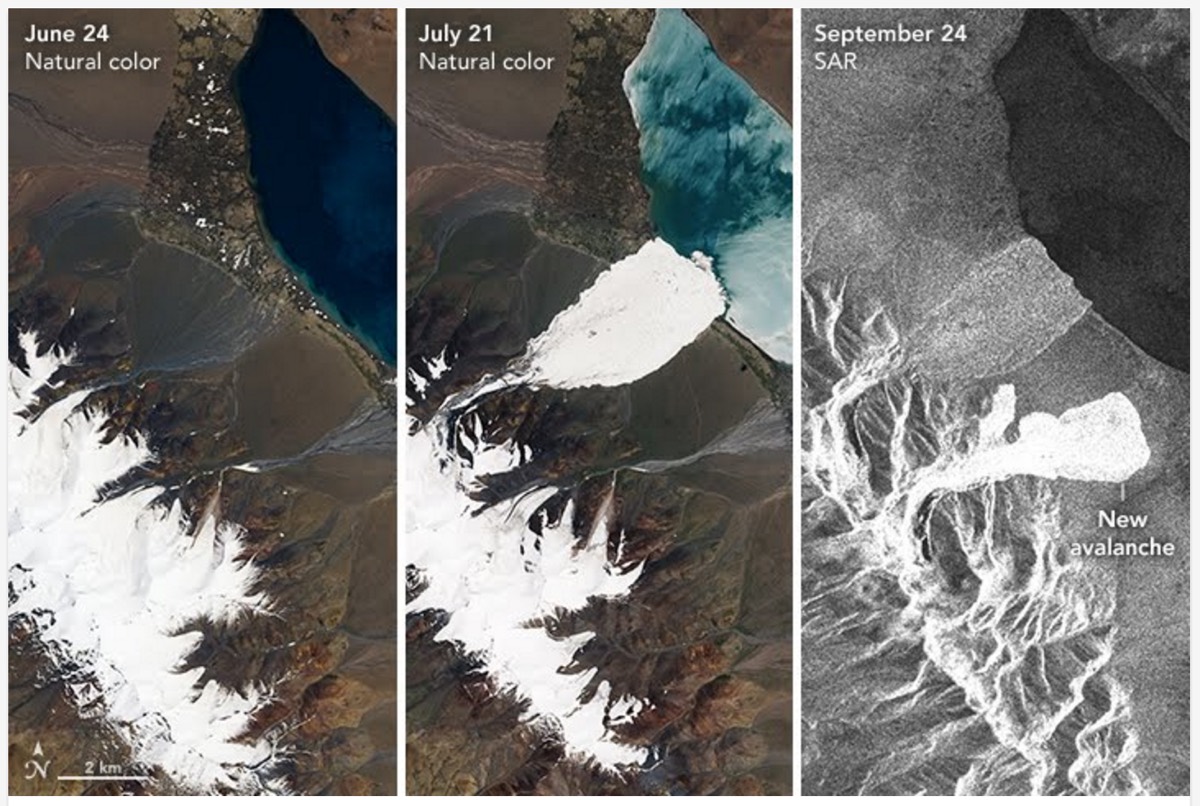'Unprecedented' Twin Avalanches Puzzle Glaciologists

An icy whodunit is gripping glaciologists puzzled over two massive ice avalanches in Tibet that seemed at first to have no culprit.
On July 17, a huge pile of ice and rock plunged nearly 0.6 miles (1 kilometer) down a valley in Tibet's Aru Range, before tumbling into a nearby lake, killing nine herders and hundreds of animals along the way, according to a scientific report on the event. The usual suspects were not in sight: Temperatures in the prior months were normal, rainfall was normal and the avalanching material had been sitting on relatively flat ground, reported NASA's Earth Observatory.
In September, the mystery deepened when another huge ice avalanche occurred nearby. "Even one of these gigantic glacier avalanches is very unusual," said Andreas Kääb, a glaciologist at the University of Oslo in Norway, as reported by the Earth Observatory. "Two of them within close geographical and temporal vicinity is, to our best knowledge, unprecedented." [See Gorgeous Photos of Glaciers in Greenland]
Fortunately, some space-y spies had captured imagery of the events: Earth-orbiting satellites, including Landsat 8, Sentinel-2 and Sentinel-1A, revealed before-and-after images of the areas where the twin avalanches occurred.
Scientists with the International Association of Cryospheric Sciences and the International Permafrost Association analyzed satellite data and also ran computer models to better understand the avalanche dynamics. Months before the July collapse, crevasses emerged and the ice height began to change, both signs of a glacier surge — a slow destabilization as ice flows from the upper to the lower part of a glacier, according to the report, authored by Kääb and other scientists.
The first glacier showed signs of surge by at least September 2015, the Earth Observatory reported. When the ice flow reached a narrow valley, it caused a blockage, which led water to build up beneath and inside of the glacier. That watery lubrication would have helped to trigger the July avalanche, the scientists said.
"[Surges] can lead to an increase of the glacier flow velocities by a factor of 10 or more, and to a rapid advance of the glacier tongue," Kääb and his colleagues wrote in their report. "But no cases have been known so far where they caused big ice avalanches" — that is, until now.
Sign up for the Live Science daily newsletter now
Get the world’s most fascinating discoveries delivered straight to your inbox.
While examining the evidence for the mysterious July ice avalanche, Kääb and his colleagues noticed similar telltale signs of surge in the neighboring spot. On Sept. 21, they alerted their Chinese colleagues, who then alerted the Chinese government of the impending collapse. However, it was too late.
"Just a few hours before the warning arrived, the second glacier had already collapsed in spectacular fashion, sending another huge load of ice spilling toward Aru Co" in western Tibet, the Earth Observatory reported. Nobody was harmed in that avalanche, the scientific report said.
The twin avalanches, occurring just a few kilometers apart, can be seen in false color in a spectacular image captured on Oct. 4 by the Advanced Spaceborne Thermal Emission and Reflection Radiometer (ASTER) aboard NASA's Terra satellite.
The glaciologists studying these avalanches said they aren't certain exactly what caused the events, but they will continue to investigate.
"A particular focus is on why two nearby glaciers failed at similar times in similar ways, a fact that points to overarching processes behind the twin events, such as meteorological conditions, longer-term climate change, or basic geological or topographic factors," the researchers wrote in their report.
Original article on Live Science.
Jeanna Bryner is managing editor of Scientific American. Previously she was editor in chief of Live Science and, prior to that, an editor at Scholastic's Science World magazine. Bryner has an English degree from Salisbury University, a master's degree in biogeochemistry and environmental sciences from the University of Maryland and a graduate science journalism degree from New York University. She has worked as a biologist in Florida, where she monitored wetlands and did field surveys for endangered species, including the gorgeous Florida Scrub Jay. She also received an ocean sciences journalism fellowship from the Woods Hole Oceanographic Institution. She is a firm believer that science is for everyone and that just about everything can be viewed through the lens of science.









